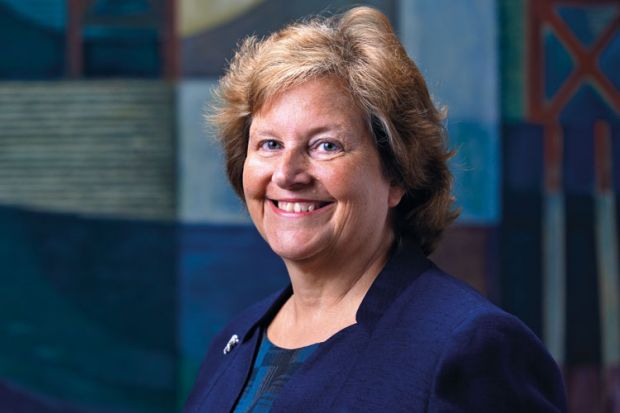Source: Micha Theiner
Pragmatism in action: Dame Ann Dowling believes that if research is really to make a difference, investment needs to carry on until an idea is ready to be implemented
For an institution whose members are at the cutting edge of technology and innovation, the track record on gender equity in the Royal Academy of Engineering’s uppermost echelon is decidedly behind the times.
Come September, the body will elect the first female president in its almost 40-year history. This is perhaps unsurprising given the startling statistic that just 4 per cent of professional engineers in the UK workforce are female, according to a recent survey by the Institution of Engineering and Technology.
But in the view of Dame Ann Dowling, the council of the Royal Academy of Engineering’s sole nominee to succeed Sir John Parker, the fact that she is a woman is unimportant. Talking to Times Higher Education ahead of the start of her tenure, the discussion revolved around her priorities for science and innovation policy, skills shortages and academia-industrial relations, rather than dwelling on the gender gap.
Dame Ann, who is head of the University of Cambridge’s engineering department, explained that during her five years in the RAE role she hopes to boost the profile of applied – or, as she likes to call it, use-inspired – research.
It is something she knows a thing or two about. Her almost 40-year career in research spans many high-profile industrial projects, including quietening the roar of Concorde, clean combustion and next-generation aircraft. She also chairs the University Gas Turbine Partnership with Rolls-Royce and in 2012 became a non-executive director at BP.
As president of the academy, she hopes to challenge the widely held notion that excellent research can happen only at the fundamental level.
“As a country we can be a bit sniffy [about applied research],” she said. “We tend to think that very fundamental blue-skies research is in some way more challenging. I see it completely the opposite way. If researchers start by trying to solve a real problem then they are inspired to go outside their comfort zone, try different techniques and think outside the box.”
She hopes to “really articulate the case” to government and industry that if research is to make a difference, investment needs to carry on until an idea is ready to be implemented. Funders typically pull out of research too early in practical development, she explained.
This could be because applied research takes longer but there may be other factors at play, she indicated. “Sometimes the research councils do not necessarily help because they are always looking for what the new thing is, rather than investing where some fundamental [work] has already started,” she said.
Innovation work needs cash
“Too often we fall back on a mantra that we are very good at core science but not so good at innovation,” said Dame Ann, who believes that the UK is in fact “very good at innovation” but does not invest enough in it.
Vince Cable, the business secretary, said in late July that the government should double the budget of the UK’s innovation agency, the Technology Strategy Board. Dame Ann agreed that the TSB, which “plays a very important role”, needs more money because its “budget is very small in comparison with [those of] the research councils”, although she admitted that she would be “less happy” if a funding increase came at the research councils’ expense.
However, she said the UK was now in a “very good place” to do more work in the applied arena, thanks to the Industrial Strategy formulated by the Department for Business, Innovation and Skills.
The sector strategy for aerospace, launched by BIS in March 2013, for example, paved the way for the creation of the UK Aerospace Technology Institute – a government-industry partnership that will invest £2 billion in research and technology over seven years. Similar collaborations are being developed in the automotive sector, Dame Ann added.
These sector-wide initiatives are intended to spark academic collaborations with industry, but such projects can present challenges. At Cambridge, Dame Ann’s engineering department has developed successful partnerships with Rolls-Royce, Dyson and Laing O’Rourke, and she maintains that open discussions are the key to good industrial relations.
“What does not work is industry saying we need someone to solve ‘x’ and trying to get academics to do a short research project on a narrowly specified thing,” she explained.
Employers’ role in training
Industry also has its opinions on engineering graduates. Every summer business leaders bemoan their lack of readiness for the world of work.
Dame Ann said she believes that employers “absolutely” have a part to play, and must take responsibility for training new recruits. There are “big demands” on space within engineering curricula so it is not possible to squeeze everything in, she said, maintaining that students’ excitement for the subject is paramount.
“Engineering is not just learning a load of facts; it is not just assimilating data. It is actually seeing how things are, what is needed and [developing] an idea that might make a difference and [then] turning that idea into a reality.”
Deciding what to teach is not the least of the problems facing engineering courses, which are among the most expensive to teach in higher education. Cambridge has a “big shortfall” on every student it admits, she said, because it spends more educating students than it can get back in tuition fees.
Dame Ann said that funds earmarked by the Higher Education Council for England to help alleviate the burden of teaching resource-intensive subjects such as engineering do not go far enough and should be increased.
“The whole of the higher education system is underfunded and financial problems are brewing…we rely heavily on donations to make up that shortfall,” she said.
Buoyant demand
The recent reforms of higher education nevertheless have had some positive effects for the discipline. Ucas figures reveal that the number of applications to read engineering before the June 2014 deadline reached almost 160,700 – up from 134,810 four years ago. Dame Ann attributes this rise to young people thinking more about the effect that university can have on careers ahead of taking on a “substantial loan”.
Dame Ann is unwaveringly enthusiastic about the career prospects for engineering students. Industry needs double the number of graduate engineers that universities are currently producing, she said, batting away questions about whether such a skills shortage really exists, given both the paucity of data and reports that have emerged to the contrary.
“We hear it first-hand from our fellows in industry,” Dame Ann said. “There is no doubt.”
Register to continue
Why register?
- Registration is free and only takes a moment
- Once registered, you can read 3 articles a month
- Sign up for our newsletter
Subscribe
Or subscribe for unlimited access to:
- Unlimited access to news, views, insights & reviews
- Digital editions
- Digital access to THE’s university and college rankings analysis
Already registered or a current subscriber? Login





